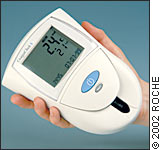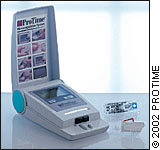
Stop treating lab results. These easy-to-use devices return the focus of warfarin therapy to treating the patient.
Fam Pract Manag. 2002;9(2):35-37
Of all available pharmaceutical therapies, coumarin anticoagulants such as warfarin represent some of the most difficult-to-manage and dangerous drugs prescribed for patients. Published studies describe the risk of major bleeding or thromboembolic events due to warfarin therapy as between 2 percent and 12 percent per year.1,2 Despite the high potential for severe side effects and myriad drug interactions, many physicians and other providers attempt therapeutic warfarin oversight without regularly scheduled anticoagulation appointments. Such a nonchalant approach to anticoagulation therapy detracts from care and reduces opportunities for appropriate reimbursement.
Common practices
Anticoagulation care is commonly delivered over extended periods without complete clinical assessments. Standing orders, which pay no attention to alterations in patient risk factors or the introduction of potentially interacting medications, direct laboratory technicians to run labs without clinical assessments. Lab results are then telephoned or mailed to the ordering office, and a physician (who may not know the patient or the indication for anticoagulation) orders therapeutic changes based primarily on International Normalized Ratio (INR) results. Finally, a nurse or other assistant telephones the patient with dosing information.
With this type of anticoagulation care, adverse warfarin effects are addressed after they happen (often in the hospital where the patient has been admitted for a thrombotic or bleeding complication) and the focus of care is diverted from patient symptoms and concerns to modifying laboratory results. Care that is neither patient-focused nor physician-directed increases the risk of mis-communication and medical mistakes.
Often, physicians aren’t reimbursed for anticoagulation care because the bulk of the care occurs via telephone. Most patients on warfarin therapy are Medicare-insured, and Medicare does not separately reimburse for telephone care. However, independent of reimbursement schemes, physicians still assume the malpractice risk associated with the oversight of these potentially hazardous drugs.
KEY POINTS
Many physicians and other providers attempt therapeutic warfarin oversight without regularly scheduled anticoagulation appointments.
Studies show that the risk of major bleeding or thromboembolic events due to warfarin therapy is between 2 percent and 12 percent per year.
Point-of-care anticoagulation devices are convenient for patients and physicians and allow for patient-focused anticoagulation care.
Patient-focused anticoagulation care
Larger practices and health care systems can alleviate some of these common problems in anticoagulation care by turning to anticoagulation clinics to arrange and manage the details of warfarin therapy. Although smaller offices have infrequent access to such resources, they need not forgo their associated benefits. With the use of point-of-care (POC), CLIA-waived anticoagulation devices, even small groups or solo practices can affordably provide all-inclusive anticoagulation assessment and warfarin management. [See “Point-of-care anticoagulation devices.”]
Using a POC anticoagulation device returns physician attention to treating patients rather than laboratory results and extends physician control over monitoring. These are important considerations given the high-risk disease states being treated (e.g., atrial fibrillation, cardiomyopathy, recurrent deep venous thrombosis and congenital heart defects) and the tendency of INR values to unpredictably wander from the baseline.
POC devices allow anticoagulation management that is convenient for patients and physicians. In a single office visit, history is updated, a physical examination is performed and, with one fingerstick, INR is accurately measured. The entire care transaction can be completed in a fraction of the time it would take to draw and process a blood sample following a traditional laboratory format.
POINT-OF-CARE ANTICOAGULATION DEVICES
Family practice offices routinely use CLIA-waived laboratory monitoring devices for assessing pregnancy status, lipid disorders, helicobacter and streptococcal infections. Recently, coagulation monitors have joined the repertoire of fast and reliable outpatient monitoring devices.
Two CLIA-waived devices, CoaguChek and ProTime, are currently available for testing whole blood for prothrombin time/International Normalized Ratio (PT/INR). The staff training time for both devices is typically less than one hour. In fact, because of their ease of use, the Food and Drug Administration has approved them for patients to use at home. The devices use thromboplastin reagents packaged in strips or “cuvettes” similar to those used in blood-glucose testing systems. Both systems have sensors that prevent results from being reported if there is an error in sample collection timing, vibration or temperature extremes. Test results are available in two to five minutes.
CoaguChek, available from Roche Diagnostics Inc., lists for $1295, plus approximately $6 per test cuvette. The quality controls, which include the electronic control strip ($300) and/or the liquid controls ($20 for four uses), are purchased separately. For more information, go to www.coaguchek.com, or call 800-852-8766.

ProTime, available from International Technidyne Corp., costs $1500, plus $10 per test cuvette. Quality controls are built in to each test cuvette. For more information, go to www.itcmed.com/protime, or call 800-631-5945.

POC devices also allow for patient-focused anticoagulation care that includes reviews of warfarin compliance and side effects, medication and dietary changes, and disease-state management goals. For example, the most common indication for warfarin therapy is to prevent stroke in patients with atrial fibrillation. Point-of-care anticoagulation assessment allows you to concurrently address other factors that contribute to stroke risk (such as hypertension and hyperlipidemia).
Billing tips
Overseeing warfarin therapy in the office rather than the lab is the first step to receiving appropriate reimbursement, since this decreases the amount of often-unreimbursed telephone care. To be adequately reimbursed for providing warfarin therapy, physicians should use the disease state being treated as the basis for their code selection, submitting CPT and ICD-9 codes for the following:
Level of office visit (i.e., CPT: 99211-99215),
Laboratory assessment of PT/INR (i.e., CPT: 85610, “Prothrombin time”),
Disease state being treated by warfarin (e.g., ICD-9: 427.31, “Atrial fibrillation”),
Long-term management of oral anticoagulants (i.e., ICD-9: V58.61).
The level of office visit should be determined by considering the level of history, exam and medical decision making involved in the encounter. Anticoagulation encounters typically include assessments of dermatologic, nervous and cardiovascular systems as well as disease-specific assessments. Encounter complexity should be governed by the treated disease state and patient-specific difficulties associated with warfarin management. Physicians should bill for anticoagulation assessments no more than every four weeks, which is the frequency suggested in practice guidelines for anticoagulation monitoring. As with many medical interventions, individual insurer policies may vary regarding warfarin therapy reimbursement.
CLINICAL RESOURCES
“Management and Dosing of Warfarin Therapy.” Gage BF, Fihn SD, White RH. The American Journal of Medicine. 2000;109:481–488.
“Decision Analysis and Guidelines for Anticoagulant Therapy to Prevent Stroke in Patients With Atrial Fibrillation.” Thomson R, Parkin D, Eccles M, Sudlow M, Robinson A. The Lancet. 2000;355:956–962.
Meeting the challenge
In the near future, direct thrombin inhibitors may replace coumarin anticoagulants as mainstays for the prevention of stroke and other thrombotic events related to mechanical heart valves, atrial fibrillation and recurrent thromboembolism.3 This newer class of drugs promises fewer interactions with foods and other medications and less intensive anticoagulation monitoring. However, until safe and effective oral formulations of these therapies become available, current anticoagulation care and billing should be upgraded to match the challenges and vagaries of warfarin management.